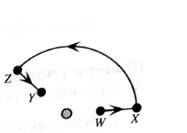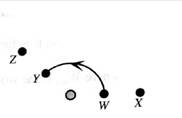
Concept explainers
Suppose the particle travels from point W to point Y along the path WXZY as shown
1. Compare the work done by the electric field when the particle travels from point W to point X to that done when the particle travels from point Z to point Y. Explain
What is the total work done on the particle by the electric field as it moves along the path WXZY?
2. Suppose the particle travels from W to Y along the arc shown. Is the work done on the particle by the electric field positive, negative, or zero? Explain using force and displacement vectors.

3. Suppose the particle travels along the straight path WY. Is the work done on the particle by the electric field positive, negative, or Zero? Explain using force and displacement vectors. (Hint: Compare the work done along the first half of the path to the work done along the second half.)

Learn your wayIncludes step-by-step video

Chapter 5 Solutions
Tutorials in Introductory Physics
Additional Science Textbook Solutions
Physics for Scientists and Engineers with Modern Physics
College Physics
Cosmic Perspective Fundamentals
Physics for Scientists and Engineers: A Strategic Approach, Vol. 1 (Chs 1-21) (4th Edition)
Physics: Principles with Applications
Physics (5th Edition)
- Someone drops a 50 — g pebble off of a docked cruise ship, 70.0 m from the water line. A person on a dock 3.0 m from the water line holds out a net to catch the pebble. (a) How much work is done on the pebble by gravity during the drop? (b) What is the change in the gravitational potential energy during the drop? If the gravitational potential energy is zero at the water line, what is the gravitational potential energy (c) when the pebble is dropped? (d) When it reaches the net? What if the gravitational potential energy was 30.0 Joules at water level? (e) Find the answers to the same questions in (c) and (d).arrow_forwardA point charge of 31.0 nC is placed in a uniform electric held that is directed vertically upward and has a magnitude of 4.60x104 V/m Part A Find the work done by the electric force when the charge moves a distance of 0 470 m to the right? Express your answer in Joules. Vol AzQ Submit Request Answer Part B Find the work done by the slectrc force when the chargo movus a distance of0.630 m upwardz Express your answer in joules. vol Azarrow_forwardQuestion 2 Calculate the electric potential energy for each of the four given systems in the shown in Figure 2. Please note that each system (Figures 2. a, b, c, and separately. Comment the obtained results. should be solved Q= (4neo)0.5 C, d= 10 cm. d d -Q la Figure 2.arrow_forward
- Will rate!! A Freebody diagram is foreign object is shown in the figure. FA = 420 N, FB = 300 N, FC = 275N, and FD = 295N. Assume angle left = 31degrees, and alpha =13 degree. How much work in (J) does FA do on the object if it moves 2.9 m downward?arrow_forwardAs shown in the figure below, a skateboarder starts at point A on the ramp and rises to point B, a maximum height of h = 2.43 m above the top of the ramp. V If the amount of work done against friction is insignificant, determine his initial speed (in m/s) at point A. m/sarrow_forward= 1. Suppose that C is the top-half of the circle (ra)² + y² a², (a > 0) oriented in the counterclockwise direction. Let F be a force field that has constant magnitude c and always directed from (x, y) toward the origin. The work done by the force F on a particle that moves along Cis LF F.Tds 2ac. Explain how do we obtain this formula.arrow_forward
- The following image shows six graphs of Energy versus distance (rr). In each graph, the orange curve labeled K represents kinetic energy, the blue curve labeled U represents the potential energy, and the green line labeled K+U represents the total energy. Indicate which graph (by number) best represents each of the scenarios described below. 1. Two electrons are a significant distance away from each other and move with nonzero initial speeds heading straight towards each other. When they get very close, they momentarily stop and then start moving away from each other. 2. A proton and an electron are moving away from each other with high initial speeds. When they are infinitely far away from each other, they are still moving. 3. A comet swings by close to the Sun and then moves away. The comet's speed is zero when it is very, very far away from the Sun. 4. A rock is ejected from a volcano on Io (one of Jupiter's moons) with a speed that is exactly equal to Io's escape speed. 5.…arrow_forwardChoose the correct answer Your Lecturer in class made the following statement: "We do not buy electrons from Eskom but we buy electrical energy!". Electrical Poerr can be described as electrical energy unit time. Electrical Energy can be brought from ESKOM in units of R2,50 for 1 KiloWatt- hour. How much will it cost to operate a 1200 W hairdryer continuously for 30 minutes? A. R3,00 B. R1,50 C. 60c D. R6,00arrow_forwardSuppose you lift a 25 kg box by a height of 1.0 m. How much work do you do in lifting the box? Instead of lifting the box straight up, suppose you push it up a 1.0 m high ramp that makes a 30 degree angle with the horizontal, as shown in (Figure 1). Being clever, you choose a ramp with no friction. How much force is required to push the box straight up the slope at a constant speed? How long is the ramp? Use your force and distance results to calculate the work you do in pushing the box up the ramp.arrow_forward
- PROVIDE COMPLETE AND ORGANIZED SOLUTION, IF NECESSARY. INCLUDE UNITS IN THE SOLUTION & FINAL ANSWER. ENCLOSE FINAL ANSWERS IN BOXES 5. A man (on a coaster) slides down a roller coaster, starting from rest, from an initial height of 25 meters as shown in the figure below. The initial potential energy of the man(with the coaster) is 2.6 x 10° J. Assume there is no friction between the coaster and track. A. What is the initial KE of the system? B. What would be the KE of the system at point b? C. What is the KE of the system at point c? D. What is the Speed at point C?arrow_forward1. Is the amount of energy you spend always the same as the amount of work you accomplish? Explain. 2. Is the amount of work accomplished dependent on the path taken to move the object a particular distance? Explainarrow_forwardAs shown in the figure below, a skateboarder starts at point A on the ramp and rises to point B, a maximum height of h = 2.83 m above the top of the ramp. If the amount of work done against friction is insignificant, determine his initial speed at point A. m/s Aarrow_forward
 University Physics Volume 1PhysicsISBN:9781938168277Author:William Moebs, Samuel J. Ling, Jeff SannyPublisher:OpenStax - Rice University
University Physics Volume 1PhysicsISBN:9781938168277Author:William Moebs, Samuel J. Ling, Jeff SannyPublisher:OpenStax - Rice University
